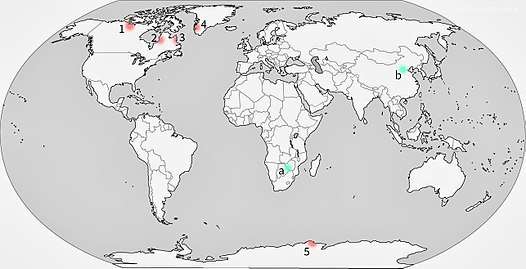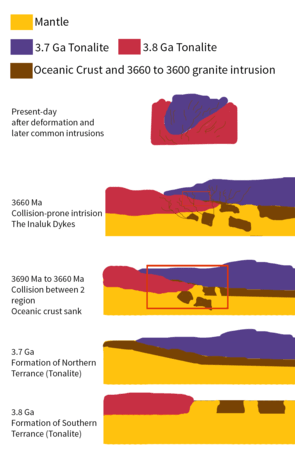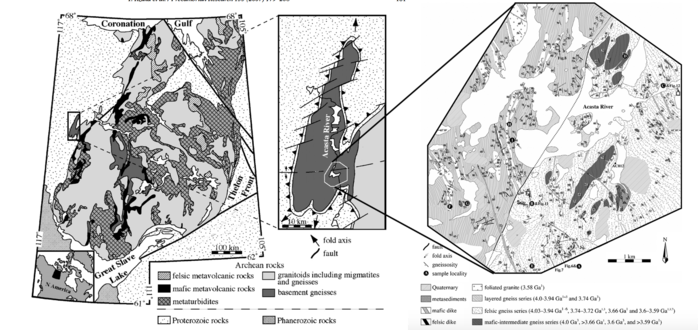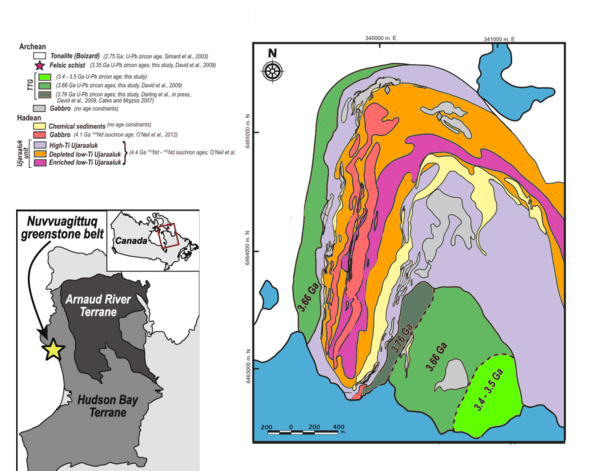Eoarchean geology
Eoarchean geology is the study of the oldest preserved crustal fragments of Earth during the Eoarchean era from 4 to 3.6 billion years ago. Major well-preserved rock units dated Eoarchean are known from three localities, the Isua Greenstone Belt in Southwest Greenland, the Acasta Gneiss in the Slave Craton in Canada, and the Nuvvuagittuq Greenstone Belt in the eastern coast of Hudson Bay in Quebec. From the dating of rocks in these three regions scientists suggest that plate tectonics could go back as early as Eoarchean.
All 3 regions contain an abundance of Archean felsic volcanic rocks, including tonalite, trondhjemite and granodiorite (TTG) series rocks,[1] with minor granulite to amphibolite facies gneiss complexes, which means that the original characters of the rocks has been disturbed by at least one ductile deformation at deep crustal conditions.[2]
Eoarchean geology is important in investigating earth's tectonic history. It is because the earth had just undergone an transformation to the present-day-similar convective mode and lithosphere from a magma ocean in Hadean Eon, to either a protoplate tectonics or an unstable stagnant lithosphere lid at its infant stages.[3] The earth's condition during Archean to Proterozoic (including Eoarchean era) serves as a crucial linkage between Hadean magma ocean to present-day plate tectonics.[3] Various interpretations have been suggested to explain the prevalent tectonic style corresponding to Eoarchean geology. However it can be, in general, classified into two tectonic models, which are vertical tectonics and plate tectonics.[3]
Explanation on the release of large amount of mantle heat is the prominent concern. Most of the evidences shows a probability that pre-plate tectonics dominantly involved intense surface volcanism, active magmatism and crustal recycling.
Occurrence of Eoarchean rocks
Eoarchean geology is dominated by:
(1) Mafic to ultramafic volcanics
(2) Tonalite-Trondhjemite-Granodiorite (TTG)
(3) Chemical sedimentary rocks such as chert and Banded-Iron-Formations (BIF)
(4) Subordinate clastic sedimentary rocks.
| Name | Age of the Formation | Location | dominant rock type | Remarks |
|---|---|---|---|---|
| Acasta Gneisses | 4.03 Ga to 3.96 Ga | Slave Craton in Northwest Canada | Highly deformed TTG, with interleaving amphibolite, ultramafic rocks and pink granites | |
| Napier Complex | 3.95 Ga to 3.8 Ga | Enderby Land, Antarctica | TTG, which has sedimentary protoliths | |
| Itsaq Gneiss Complex | Akulleq terrance at 3.9 Ga to 3.8 Ga | Southwest Greenland | Amitsoq TTG complex | The largest and best-preserved fragment of Eoarchean continental crust |
| Saglek-Hebron block | 3.86 Ga to 3.73 Ga | East coast of Labrador | supracrustal assemblage in Nulliak unit; Gneiss in Uivak units | The region is divided into three regions; they are Nulliak, Uivak I and Uivak II |
| Nuvvuagittuq Supracrustal Belt | about 3.8 Ga | Superior Province, Quebec | Two greenstone assemblage successions (1)Conglomerate, Garnet paragneisses, chemical sedimentary rocks
(2)Volcanic rocks, magic to intermediate tuff and chemical sedimentary rocks |
There are some zircon dated back to eoarchean, but not necessarily indicate the host rock was formed in Eoarchean, in
(1) Anshan Area in North China Craton[4]
(2) Sebakwe Protocraton in Zimbabwe Craton[4]

Isua Greenstone Belt and the Isua Area

The Isua Greenstone Belt, also as known as the Isua Supracrustal Belt, at the Isukasia terrance in Southwestern Greenland preserves the oldest and well-preserved sedimentary and volcanic rocks dated between 3.7 and 3.8 billion years old. The 35-km long, 4 km wide greenstone belt had been deformed into a thin U-shape[5] pointing to the Southwest direction with an approximate diameter of 25 km.[6] It consists mainly of amphibolite metamorphosed from basalt, with chemical rocks, felsic units and ultra mafic units.[2]
Isua Greenstone Belt is part of the Isua Area, in which most of the lithology are orthogneiss.[2] This orthogneiss are named after Amîtsoq Gneiss. Geologist often regionally divide the entire Isua Area into two parts along the isua greenstone belt. The core of the U-shaped Isua belt, or the "northern gneisses", are mostly tonalite to granitic rock,[7] while the south to the belt or the "southern gneisses" are similar granitoid rocks.[7] Contacts between the belt and the gneisses are in general strongly deformed and myloitic.[7]
According to the geology in Isua Greenstone Belt, the tectonic style in Isua area is still controversial. Either vertical plate tectonics[8] or proto-plate tectonics[2] subduction is viable. Geologists who are porto-plate tectonic advocates often divide the Isua area into northern and southern terrane by the average dated age from the gneiss in each terrane.[9] Between these two chronologically different regions, a thin sedimentary unit lying in the Isua Greenstone Belt is the dividing boundary.[2] These two terrane were juxtaposed and assembled between either 3680 to 3660 Ma[10] or 3650 to 3600 Ma.[11]
Lithologies
The Isua Greenstone Belt contains geology that were mostly deformed during eoarchean. In most areas, primary volcanic and sedimentary structure were obliterated.[10] However, in rare low strain area, original structure in protolith are still visible in present days. The major lithologies in Isua belt are (1) tonalites of the Amîtsoq gneiss, (2) Basaltic pillow lava and pillow breccia and (3) Banded Iron formation.[2]
Presence of the above lithologies is an indicator of paleo-environment because,
(1) The Amitsoq gneiss often shows graded felsic clast units, which means a derivation from felsic volcanic or felsic volcano-sedimentary rock.[11]
(2) Presence of pillow-structured lava and breccia indicated that there were liquid water in eoarchean ages.[11]
(3) Banded Iron Formation (BIF), with minor metachert unit, is an indicator for coeval deposition of aqueous clastic and chemical sediment.[11]
Subsequent U-Pb zircon-dating program has been done to test the rock ages. It demonstrated that the belt contains supracrustal rocks lying in the age range between 3.8 and 3.7 billion years ago,[12] having an only ~100 million year variation of age within the belt.[12] 3.8 billion year old rock are dominantly concentrated at the southern part of the belt while the 3.7 billion old counterpart are dominated at the centre and northern part.[12] It has been undergone three isolated phases of metamorphism, at least one of them occurred in early Archean.[7]
Similar looking Amitsoq Gneiss bounds the Isua belt from North and from the South.
North to the Isua Greenstone Belt
To the north, the Isua supracrustal belt is bounded by orthogneiss. Dominant tonalitic gneisses shows a protolith age of about 3.7 billion years ago.[12] A low strain area of several square kilometres are observed at the immediate north to the Isua Belt.[9] Dominant phases are foliated metatonalites, in which several localities shows 3660 Ma diorite and 3655 to 3640 Ma granite and pegmatite.[13] They invaded the host orthogneiss by intrusion. Yielded ages from the tonalites in the northern terrane are between 3720 and 3690 Ma,[2] which is 100 million years young to those in the southern region.
South to the Isua Greenstone Belt
Southern region from the Isua Belt is mostly composed of similar orthogneiss as the northern region is. However, the ages yielded from the protoliths are between 3872 and 3700 Ma.[9] The ages of the rock are generally 100 million years older than that in the northern terrane.
Amphibolites showing localised pillow structure reflects a submarine basaltic environment in the past.[2]Zircon overgrowth indicates an event of high-grade metamorphism between 3660 and 3650 Ma.[9]
Tectonics

Subduction and lateral proto-plate tectonics
There is not a widely accepted tectonic explanation for the formation of Isua greenstone belt and the adjacent area. However, there are some viable models. One of the suggested explanation is proto-plate tectonics, with a convergent plate margin involved.[2]
A 3660 Ma to 3690 Ma collision is possible between the northern 3.7 Ga region and the 3.8 Ga region, along a thin layer of sedimentary dividing unit in the Isua Greenstone belt.
Both terrance shows episodic deposition of volcanic Tonalite-Trondhjemite-Granodiorite TTG. And in TTG yielded an age between 3720 and 3710 Ma, composition of these relatively juvenile igneous rock shows that it is from partial melting of eclogitized mafic material, with high magnesium but low silica content. Partial melting of a subduction-indicating rock shows that the environment was a convergent plate boundary or a subduction zone setting.[10]
A thin layer of metasedimentary unit derived mainly from Banded Iron Formation, chert and carbonate rocks is believed to be the dividing unit of 3.8 Ga region and 3.7 region. In some well-exposed area, highly tectonized and recrystallised mylonites are present.[2]
Docking of the old and new block happened between the earliest 3690 Ma and the latest 3660 Ma.[2] As 3690 Ma was the age yielded from the youngest tonalite,[11] which is only native in Northern terrane. It indicates a high possibility at 3690 Ma of a far distance between the northern region and the southern region. And 3660 Ma is the age yielded from the ultramafic-to-dioritic Inaluk dykes,[11] which is a common intrusion in both terrane. Therefore, It is a strong evidence showing that these two plate had been collided to each other.
Alternative tectonic model: vertical tectonics
As plumes and impacts structures are observed in Isua area, it is skeptical that "vertical tectonics" are also viable in the construction of Eoarchean Isua Area.[11] In addition, the material in lateral transport on thrusts are recorded from both plume-related volcanic centers and in impact centres. This hypothesis will be closer to viable if further more pieces of evidence for vertical tectonics such as dome-and-syncline regional diapir[8] structural patterns are observed in the area. Isua Greenstone Belt is currently under heavy investigation as it give a hint of early earth's tectonics.
Acasta Gneiss Complex
The Acasta Gneiss Complex is located in the western part of the Slave Province,[14] and is well exposed along the Acasta river. The Acasta Gnessis Complex contains the oldest known felsic rocks on Earth, with ages up to 4.02 Ga[15][16] but have rocks as young as 2.95 Ga[17]. It is part of the Slave Province which covers an area approximately 190,000 km2. After the initial documentation of very ancient zircons present in the Acasta River area[15], a significant scientific debate regarding the true age of these important rocks was born. Some geologists suggested that all rocks in the Acasta region were highly metamorphosed and altered 3.3 billion years ago, so that their zircon ages were not reflective of the true ages of the rocks[18]. This debate culminated in a series of papers and comments regarding the discrepancy between zircon age information and whole-rock data[19][20][21]. The age debate has been mostly resolved by further work in the Acasta area by several research groups as well as the general acceptance by the scientific community of using in situ zircon U-Pb to obtain ages from complicated rocks. Although complicated rocks, with multiple age domains mixed together, do certainly exist in the Acasta region[22], much simpler rocks are definitively present as well[23][24] so the entire Complex was clearly not wholesale overprinted by 3.3 Ga metamorphism. The oldest known rock unit in the Acasta region is a 4.02 Ga tonalitic unit termed the Idiwhaa Tonalitic Gneiss[23].
Notably, one xenocrystic zircon core, which was included in a 3.92 Ga gneiss, has been dated to 4.2 Ga, which is the oldest age recorded in the Acasta area[25]. However, the rock that originally grew this zircon has not been found, and it may not even exist anymore. The ages of rocks in the Acasta Gneiss Complex have peaks at 3.92-4.02 Ga, 3.75 Ga, 3.6 Ga, and 3.4 Ga[26][24] which document major crust forming events.

Lithologies
Dominant rocks in the region are variably deformed tonalitic, granodioritic, and granitic, and amphibolitic gneisses[14][24][17]. Mafic rocks such as amphibolite and ultra mafic rocks are also present in Acasta Gneiss Complex and occur in variable proportions throughout the Complex. A north-east trending fault divide the area into two domain[24].
Eastern domain
The eastern area is an abundance of relatively massive tonalitic, granodioritic and granitic gneiss and gabbroic, dioritic and quartz-dioritic gneisses are present.[24] Four episodes of tonalite-granite emplacement shows ages of 3.94-4.02, 3.74, 3.66 and 3.59 Ga.[1][17]
Western Domain
The western area is a dominance of layered quartz dioritic to dioritic, tonalitic to granitic gneiss and young foliated granitic intrusions.[24] It shows a formation of the granitic protolith of the layered gneiss at 3.97 Ga, followed by a 3.58 Gyr old granitic intrusion, which has been foliated.[1]
Mafic enclaves and inclusions
Mafic rocks are distributed within the entire Acasta Gneiss Complex as minor blocks such as enclaves and bands. The mafic rocks consist of massive to slightly foliated amphibolite, garnet amphibolite as well as hornblendite.[1][17][24] Mineral composition indicates that they had experienced metamorphism between amphibolite to upper amphibolite facies.[1]
Tectonics
Though there is no well-accepted tectonic setting that formed the Acasta Gneiss Complex, various hypotheses have been proposed. First, the oldest rocks in the Acasta region, the Idiwhaa Tonalitic Gneiss, shows a distinctive geochemistry of high Fe but low Mg content, and a relatively flat REE pattern. Compositions like this occur in very few locations on the modern Earth, including modern Iceland. This led to the idea that the earliest phase of crust formation in the Acasta region occurred by petrologic processes similar to modern Iceland, that is, shallow intrusion of dry basalts and partially melting at low pressures[17][23]. Something changed at 3.6 Ga, however, as the rocks formed in the Acasta Gneiss Complex have very different geochemical signatures at this time. This led to proposals for a subduction-like setting, or mobile-lid setting, at 3.6 Ga in the Acasta area[27]. Other workers, using the Thorium-to-niobium ratio in the amphibolites, suggested that subduction occurred much earlier, closer to 4.0 Ga[1].
Nuvvuagittuq Greenstone Belt and the adjacent TTG
Nuvvuagittuq Greenstone Belt (NGB) is located in the Northern Quebec, covering approximately 10 km2 of area in Hudson Bay.[28] It resembles a north-closing synform that plunges towards the south direction.[28]
The true age of NGB is still controversial and between 4.4 Gyr year[29] to 3.8 Gyr old.[30] The 4.4-Gyr-old zircon in NGB does not, by its low isotopic ratio of 142-Neodymium to 144-Neodymium, represent that the mafic host rock is also of Hadean age. And the oldest detrital zircon with high correspondence to the host rock is yielded an age of 3780 Ma.[30]
Lithologies

Into three lithological units, the Nuvvuagituq Greenstone Belt is divided.[31][32]
(1) Ujaraaluk unit which an amphibolite unit enriched in cummingtonite, plagioclase and biotite, and depleted in hornblende.
(2) gabbroic and ultramafic intrusive bodies, and
(3) chemical sedimentary protolith, i.e. banded iron formation (BIF) and banded silicate formation (BSF).[33]
Within the largest unit, Ujaraaluk amphibolite, a progression of garnet content and a regression of chlorite and epidote from west to east shows an intensification of metamorphism of amphibolite from green-schist facies to an upper-amphibolite facies.[31]
Surrounding tonalites, trondhjemites and granodiorites
The Nuvvuagituq Belt is bounded by eoarchean tonalites, trondhjemites and granodiorite aged around 3660 Ma, and further surrounded by younger approximately 2750 Ma tonalities.[34] Surrounding tonalites, trondhjemites and granodiorites (TTGs) are the product of partial melting of Hadean Mafic lithologies, which was similar to the Ujaraaluk unit. The remelt products of "Hadean Ujaraaluk" and the exposed, eoarhcean Ujarraluk unit share similar geochemical composition i.e. isotopic ratio between 142-Neodymiun to 144-Neodymium.[28] TTG-Felsic crusts formed in multiple episodes. By U-Pb zircon geochronology, the fourfold episodic TTGs were yielded 3.76 Ga, 3.66 Ga, 3.5–3.4 Ga and 3.35 Ga.[34] The surrounding TTG are suggested to be an indicator for paleo subduction systems.
Tectonics
Proto-plate tectonics
Crustal recycling derived the TTG surrounding the Nuvvuagituq Belt from arc-like source rocks, i.e. Ujaraaluk Unit. A large scale of a simultaneous accumulation of TTG and subsequent partial melting only occurs in particular tectonic settings.[29] It is viable that the production is related to crust recycling in which the mafic crust and water were returned to the mantle, and as a consequence, arc-like mafic magma formed.[29] This somehow resembles a subduction system in modern plate tectonics but it is not sensible to explain the entire model back to eoarchean as the geologic evidence is still insufficient.
References
- Koshida, Keiko; Ishikawa, Akira; Iwamori, Hikaru; Komiya, Tsuyoshi (2016). "Petrology and geochemistry of mafic rocks in the Acasta Gneiss Complex: Implications for the oldest mafic rocks and their origin". Precambrian Research. 283: 190–207. Bibcode:2016PreR..283..190K. doi:10.1016/j.precamres.2016.07.004.
- Nutman, Allen P.; Friend, Clark R.L. (2009). "New 1:20,000 scale geological maps, synthesis and history of investigation of the Isua supracrustal belt and adjacent orthogneisses, southern West Greenland: A glimpse of Eoarchaean crust formation and orogeny". Precambrian Research. 172 (3–4): 189–211. Bibcode:2009PreR..172..189N. doi:10.1016/j.precamres.2009.03.017.
- Stern, Robert J. (2008). "Modern-style plate tectonics began in Neoproterozoic time: An alternative interpretation of Earth's tectonic history". The Geological Society Special Paper. 440: 265–279.
- Condie, Kent (2007). "The distribution of Paleoarchean crusts". Development in Precambrian Geology. 15.
- Polat, A.; Hofmann, A. W. (2003). "Alteration and geochemical patterns in the 3.7–3.8Ga Isua greenstone belt, West Greenland". Precambrian Research. 126 (3–4): 197–218. doi:10.1016/S0301-9268(03)00095-0.
- Crowley, J.L. (2003). "U–Pb geochronology of 3810–3630 Ma granitoid rocks south of the Isua greenstone belt, southern West Greenland". Precambrian Research. 126 (3–4): 235–257. doi:10.1016/S0301-9268(03)00097-4.
- Rollison, Hugh (2003). "Metamorphic history suggested by garnet-growth chronologies in the Isua Greenstone Belt, West Greenland". Precambrian Research. 126 (3–4): 181–196. Bibcode:2003PreR..126..181R. doi:10.1016/S0301-9268(03)00094-9.
- Moore, William B.; Webb, A. Alexander G. (2013). "Heat-pipe Earth". Nature. 501 (7468): 501–505. Bibcode:2013Natur.501..501M. doi:10.1038/nature12473. PMID 24067709.
- Nutman, Allen P.; Friend, Clark R. L.; Kinny, Peter D.; McGregor, Victor R. (2013). "Anatomy of an Early Archean gneiss complex: 3900 to 3600 Ma crustal evolution in southern West Greenland". Geology. 21 (5): 415–418. doi:10.1130/0091-7613(1993)021<0415:AOAEAG>2.3.CO;2.
- Nutman, Allen P.; Bennett, Vickie C.; Friend, Clark L.; Hidaka, Hiroshi; Yi, Keewook; Lee, Seung Ryeol; Kamichi, Tomoyuki (2013). "The Itsaq Gneiss complex of Greenland: Episodic 3900 to 3660 Ma Juvenile crust formation and recycling in the 3660 to 3600 Ma Isukasian Orogeny". American Journal of Science. 313 (9): 877–911. Bibcode:2013AmJS..313..877N. doi:10.2475/09.2013.03.
- Nutman, Allen P.; Friend, Clark R.L.; Bennett, Vickie C. (2002). "Evidence for 3650–3600 Ma assembly of the northern end of the Itsaq Gneiss Complex, Greenland: Implication for early Archaean tectonics". Tectonics. 21: 1–28.
- Nutman, A.P.; McGregor, V. R.; Friend, C.R.L.; Bennett, V.C.; Kinny, P.D. (1996). "The Itsaq Gneiss Complex of southern West Greenland; the world's most extensive record of early crustal evolution (3900–3600 Ma)". Precambrian Research. 78 (1–3): 1–39. Bibcode:1996PreR...78....1N. doi:10.1016/0301-9268(95)00066-6.
- Nutman, A. P.; Bennett, V.C.; Friend, C.R.:.; McGregor, V.R. (2000). "The early Archaean Itsaq Gneiss Complex of southern West Greenland: the importance of field observations in interpreting age and isotopic constraints for early terrestrial evolution". Geochim. 64 (17): 3035–3060. Bibcode:2000GeCoA..64.3035N. doi:10.1016/S0016-7037(99)00431-7.
- St-Onge, M R; King, J E; Lalonde, A E (1988). "Geology, East - Central Wopmay Orogen, District of Mackenzie, Northwest Territories". doi:10.4095/130452. Cite journal requires
|journal=(help) - Bowring, S. A.; Williams, I. S.; Compston, W. (1989). "3.96 Ga gneisses from the Slave province, Northwest Territories, Canada". Geology. 17 (11): 971. doi:10.1130/0091-7613(1989)017<0971:ggftsp>2.3.co;2. ISSN 0091-7613.
- Reimink, J. R.; Davies, J. H. F. L.; Chacko, T.; Stern, R. A.; Heaman, L. M.; Sarkar, C.; Schaltegger, U.; Creaser, R. A.; Pearson, D. G. (2016-09-19). "No evidence for Hadean continental crust within Earth's oldest evolved rock unit". Nature Geoscience. 9 (10): 777–780. doi:10.1038/ngeo2786. ISSN 1752-0894.
- Reimink, Jesse R.; Chacko, Thomas; Stern, Richard A.; Heaman, Larry M. (August 2016). "The birth of a cratonic nucleus: Lithogeochemical evolution of the 4.02–2.94Ga Acasta Gneiss Complex". Precambrian Research. 281: 453–472. doi:10.1016/j.precamres.2016.06.007. ISSN 0301-9268.
- Moorbath, S.; Whitehouse, M.J.; Kamber, B.S. (March 1997). "Extreme Nd-isotope heterogeneity in the early Archaean — fact or fiction? Case histories from northern Canada and West Greenland". Chemical Geology. 135 (3–4): 213–231. doi:10.1016/s0009-2541(96)00117-9. ISSN 0009-2541.
- Whitehouse, Martin J.; Nagler, Thomas F.; Moorbath, Stephen; Kramers, Jan D.; Kamber, Balz S.; Frei, Robert (2001-03-29). "Priscoan (4.00–4.03 Ga) orthogneisses from northwestern Canada - by Samuel A. Bowring and Ian S. Williams: discussion". Contributions to Mineralogy and Petrology. 141 (2): 248–250. doi:10.1007/s004100100240. ISSN 0010-7999.
- Sanborn, N; Stern, R; Desgreniers, S; Botton, G A (2000). "Microstructure of Neoarchean zircon from the Acasta gneiss complex, Northwest Territories; Radiogenic age and isotopic studies: Report 13". doi:10.4095/211627. Cite journal requires
|journal=(help) - Bowring, Samuel A.; Williams, Ian S. (1999-01-21). "Priscoan (4.00-4.03 Ga) orthogneisses from northwestern Canada". Contributions to Mineralogy and Petrology. 134 (1): 3–16. Bibcode:1999CoMP..134....3B. doi:10.1007/s004100050465. ISSN 0010-7999.
- Mojzsis, Stephen J.; Cates, Nicole L.; Caro, Guillaume; Trail, Dustin; Abramov, Oleg; Guitreau, Martin; Blichert-Toft, Janne; Hopkins, Michelle D.; Bleeker, Wouter (May 2014). "Component geochronology in the polyphase ca. 3920Ma Acasta Gneiss". Geochimica et Cosmochimica Acta. 133: 68–96. doi:10.1016/j.gca.2014.02.019. ISSN 0016-7037.
- Reimink, J.R.; Chacko, T.; Stern, R.A.; Heaman, L.M. (2014). "Earth's earliest evolved crust generated in an Iceland-like setting". National Geosciences. 7 (7): 529–533. Bibcode:2014NatGe...7..529R. doi:10.1038/ngeo2170.
- Iizuka, Tsuyoshi; Komiya, Tsuyoshi; Ueno, Yuichiro; Katayama, Ikuo; Uehara, Yosuke; Maruyama, Shigenori; Hirata, Takafumi; Johnson, Simon P.; Dunkley, Daniel J. (2007). "Geology and zircon geochronology of the Acasta Gneiss Complex, northwestern Canada: New constraints on its tectonothermal history". Precambrian Research. 153 (3–4): 179–208. Bibcode:2007PreR..153..179I. doi:10.1016/j.precamres.2006.11.017.
- Iizuka, Tsuyoshi; Horie, Kenji; Komiya, Tsuyoshi; Maruyama, Shigenori; Hirata, Takafumi; Hidaka, Hiroshi; Windley, Brian F. (2006). "4.2 Ga zircon xenocryst in an Acasta gneiss from northwestern Canada: Evidence for early continental crust". Geology. 34 (4): 245. Bibcode:2006Geo....34..245I. doi:10.1130/g22124.1. ISSN 0091-7613.
- Reimink, Jesse R.; Chacko, Thomas; Stern, Richard A.; Heaman, Larry M. (August 2016). "The birth of a cratonic nucleus: Lithogeochemical evolution of the 4.02–2.94Ga Acasta Gneiss Complex". Precambrian Research. 281: 453–472. doi:10.1016/j.precamres.2016.06.007. ISSN 0301-9268.
- Reimink, Jesse R.; Chacko, Thomas; Carlson, Richard W.; Shirey, Steven B.; Liu, Jingao; Stern, Richard A.; Bauer, Ann M.; Pearson, D. Graham; Heaman, Larry M. (July 2018). "Petrogenesis and tectonics of the Acasta Gneiss Complex derived from integrated petrology and 142Nd and 182W extinct nuclide-geochemistry". Earth and Planetary Science Letters. 494: 12–22. doi:10.1016/j.epsl.2018.04.047. ISSN 0012-821X.
- O'Neil, Jonathan; Carlson, Richard W.; Paquette, Jean-Louis; Francis, Don (2012). "Formation age and metamorphic history of the Nuvvuagittuq Greenstone Belt". Precambrian Research. 220–221: 23–44. Bibcode:2012PreR..220...23O. doi:10.1016/j.precamres.2012.07.009.
- Adam, John; Rushmer, Tracy; O'Neil, Jonathan; Francis, Don (2012). "Hadean greenstones from the Nuvvuagittuq fold belt and the origin of the Earth's early continental crust". Geology. 40 (4): 363–366. Bibcode:2012Geo....40..363A. doi:10.1130/G32623.1.
- Cates, Nicole L.; Ziegler, Karen; Schmitt, Axel K.; Mojzsis, Stephen J. (2013). "Reduced, reused and recycled: Detrital zircons define a maximum age for the Eoarchean (ca. 3750–3780 Ma) Nuvvuagittuq Supracrustal Belt, Québec (Canada)". Earth and Planetary Science Letters. 362: 283–293. doi:10.1016/j.epsl.2012.11.054.
- O'Neil, J.; Maurice, C.; Stevenson, R. K.; Larocque, J.; Cloquet, C.; David, J.; Francis, D. (2007). The Geology of the 3.8 Ga Nuvvuagittuq (Porpoise Cove) Greenstone Belt, Northeastern Superior Province, Canada. Developments in Precambrian Geology. 15. pp. 219–250. doi:10.1016/S0166-2635(07)15034-9. ISBN 9780444528100.
- O'Neil, J.; Carlson, R. W.; Francis, D.; Stevenson, R. K. (2008). "Neodymium-142 evidence for Hadean Mafic Crust". Science. 321 (5897): 1828–1831. Bibcode:2008Sci...321.1828O. doi:10.1126/science.1161925. PMID 18818357.
- Mloszewska, Aleksandra; Pecoits, Ernesto; Cates, Nicole L.; Mojzsis, Stephen J.; O'Neil, Jonathan; Robbins, Leslie J.; Konhauser, Kurt O. (2011). "The composition of Earth's oldest iron formations: The Nuvvuagittuq Supracrustal Belt (Québec, Canada)". Earth and Planetary Science Letters. 317–318: 331–342. Bibcode:2012E&PSL.317..331M. doi:10.1016/j.epsl.2011.11.020.
- O'Neil, Jonathan; Boyet, Maud; Carlson, Richard W.; Paquette, Jean-Louis (2013). "Half a billion years of reworking of Hadean mafic crust to produce the Nuvvuagittuq Eoarchean felsic crust". Earth and Planetary Science Letters. 379: 13–25. Bibcode:2013E&PSL.379...13O. doi:10.1016/j.epsl.2013.07.030.